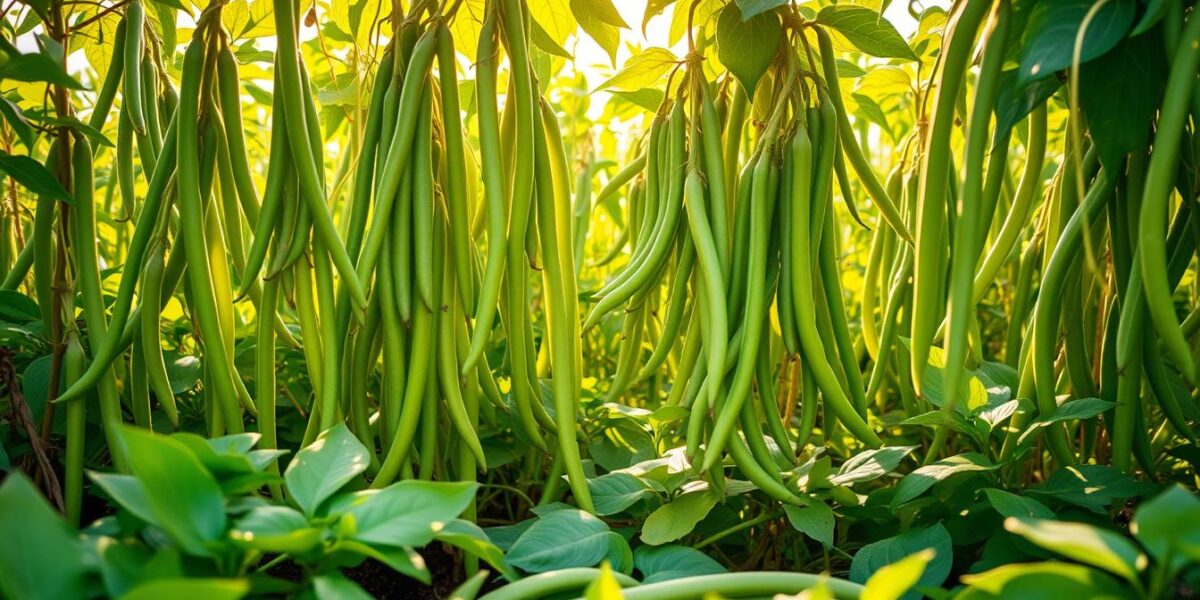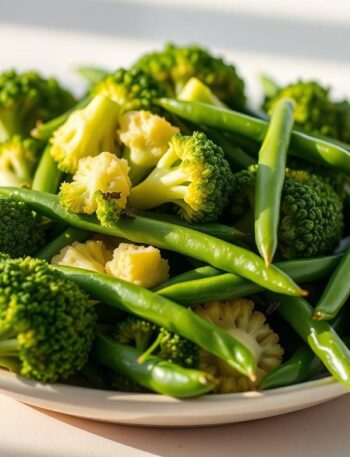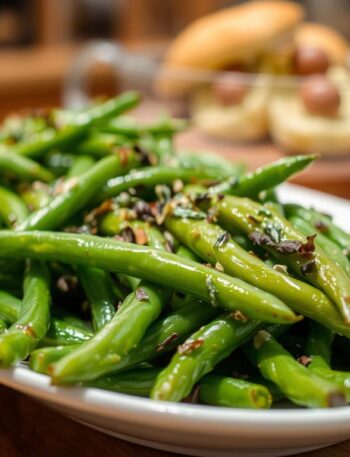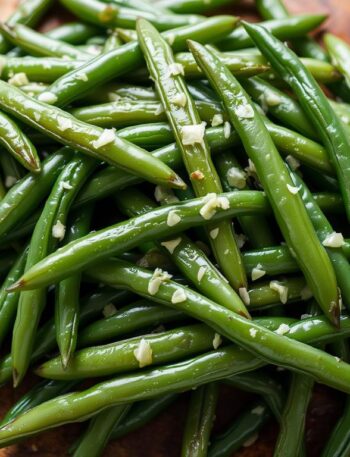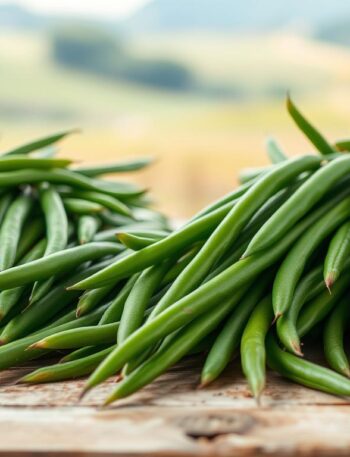Welcome to the world of half runner green beans! These finger-friendly veggies are fun to grow and super tasty to cook. We’ll show you how to grow them, so you can enjoy a lot in different dishes.
Half runner green beans are tender and full of flavor. They love sunny spots and are easy to grow, even for beginners. We’ll share tips on planting, care, and cooking them. This way, you can make delicious meals that are good for you.
Let’s start this culinary journey together. We’ll see why half runner green beans are great for your meals, from planting to enjoying them in tasty recipes. Get ready to wow your friends and family with your gardening and cooking skills!
Introduction to Half Runner Green Beans
Half runner green beans are loved for their special taste and easy growth. They grow to a height that’s easy to manage, making them great for small gardens. Their bushy habit means they do well in home gardens, giving us lots of beans to enjoy.
These beans have a long history in cooking. They have a nice texture and a mild flavor, setting them apart from other green beans. This makes them perfect for many dishes, from salads to casseroles.
Learning about half runner green beans helps us see their value in cooking. Whether we roast, steam, or sauté them, they always taste great. By knowing the different types of green beans, we can pick the best one for our meals.
Benefits of Half Runner Green Beans
Adding half runner green beans to your meals is a great choice. They are very low in calories, which is good for those watching their calorie intake. These beans are also full of vitamins A, C, and K, folate, and fiber.
They are good for your digestive health. The fiber in them helps with digestion, making you feel better overall. Plus, they boost your immune system with their vitamin content.
If you’re trying to manage your weight, these beans are a good pick. They have a lot of fiber, which keeps you full longer. This can help you avoid eating too much. Including them in your diet can help you reach your health goals.
| Nutrient | Amount per 1 cup (raw) |
|---|---|
| Calories | 34 |
| Protein | 2 g |
| Fiber | 4 g |
| Vitamin A | 16% RDI |
| Vitamin C | 30% RDI |
| Vitamin K | 16% RDI |
| Folate | 10% RDI |
Types of Green Beans and Their Characteristics
Exploring green beans, we find three main types: bush beans, pole beans, and half runner green beans. Each type has its own texture and taste. They are perfect for different dishes.
Bush Beans: Bush beans grow into a compact bush, about 1 to 2 feet tall. They are ready to harvest in 50 to 60 days. Their pods are tender and great for eating fresh.
Pole Beans: Pole beans climb up to 10 feet tall on trellises. They produce more beans over a longer time. Their pods are crisp and flavorful, perfect for stir-fries or salads.
Half Runner Green Beans: Half runner beans are a mix of bush and pole beans. They grow moderately and produce lots of pods. These pods are tender but crunchy, great for steaming, sautéing, or casseroles.
Knowing about different green beans helps us see why half runner beans are special. Each type has its own traits, but half runner beans offer great taste and texture. Choosing the right type makes our meals both tasty and healthy.
How to Grow Half Runner Green Beans
Growing half runner green beans is a rewarding hobby for gardeners. This guide will help you grow these beans successfully. We’ll cover choosing the right soil, location, planting, and caring for your plants.
Choosing the Right Soil and Location
Half runner green beans prefer light, loamy soil with good drainage. They need full sun, at least 6-8 hours a day. Before planting, check your soil’s pH. It should be slightly acidic, between 6.0 and 6.8.
If your soil lacks nutrients, add compost or well-rotted manure. This will improve its quality.
Planting and Care Instructions
Timing is key when growing half runner green beans. Plant seeds outside after the last frost. Space them 2-4 inches apart in rows 24-36 inches apart.
Once they sprout, provide stake support for climbing. Regular weeding keeps your plants healthy and prevents competition for nutrients.

| Step | Description |
|---|---|
| Soil Type | Light, loamy soil with good drainage |
| Sunlight | At least 6-8 hours of direct sunlight |
| Seed Planting | After the last frost, 2-4 inches apart |
| Row Spacing | 24-36 inches apart |
| Support | Use stakes for climbing support |
| Weeding | Regular weeding is essential |
Watering and Fertilizing Techniques
Learning to grow half runner green beans starts with knowing how to water and fertilize them. These plants need consistent moisture, aiming for about 1 inch of water each week. Before you water, check the soil to avoid overwatering, which can harm the roots, or under-watering, which slows growth.
To check soil moisture, stick your finger into the soil about an inch deep. If it’s dry, it’s time to water. Using drip irrigation or soaker hoses helps water reach the roots efficiently.
For fertilizing, use a balanced fertilizer during important growth periods. This is key for healthy growth and tasty pods. Look for a fertilizer with an NPK ratio of 10-10-10 or similar.
Here’s a quick overview of watering and fertilizing techniques:
| Technique | Details |
|---|---|
| Watering Frequency | 1 inch of water per week |
| Soil Moisture Check | Insert a finger 1 inch deep; water if dry |
| Fertilizer Type | Balanced fertilizer (e.g., 10-10-10) |
| Fertilization Timing | During flowering and pod development |
Pest Management for Healthy Plants
Learning to grow half runner green beans means knowing about pests. Aphids and beetles are big problems. We need good pest management to keep our plants healthy.
Organic methods are a great choice for pest control. Neem oil is a natural pesticide that stops pests without harming good bugs. Insecticidal soap is another option, killing pests gently but effectively.
Preventing pests is just as important. Companion planting helps by growing plants that keep pests away. Marigolds and basil, for example, keep pests off our green beans. Also, changing where we grow our beans helps avoid pest buildup.
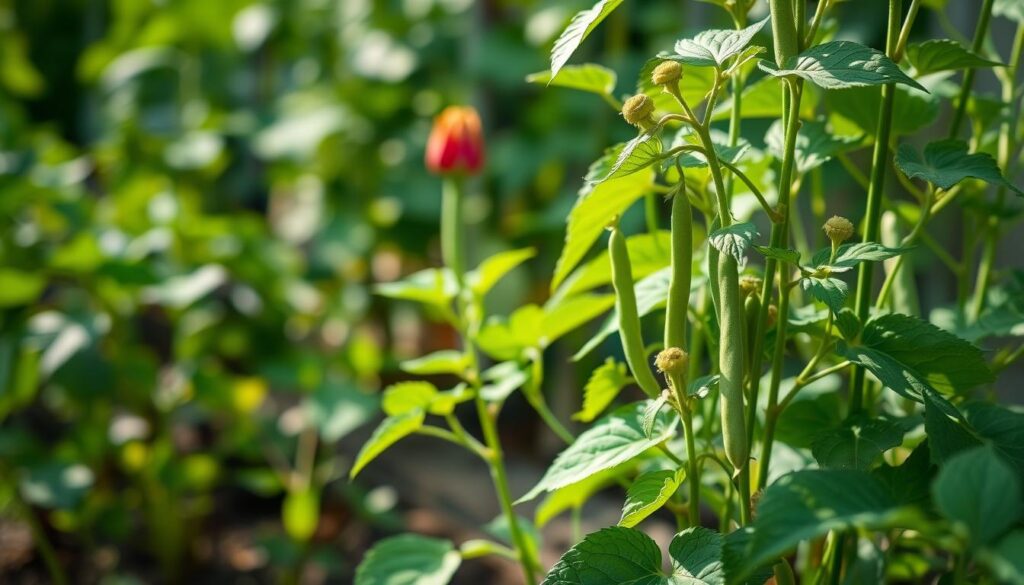
Using these methods keeps our plants healthy and productive. This leads to a big harvest of tasty half runner green beans. Being proactive makes gardening rewarding and enjoyable.
Harvesting Half Runner Green Beans
Learning to grow half runner green beans means knowing how to harvest them too. It’s all about timing. We look for beans that are 4-6 inches long and feel tender. This is when they taste the best, making our meals even more delicious.
When we harvest, we use gentle methods to protect the plants. A simple twist or a careful cut with scissors or shears works well. This way, we don’t damage the vine. By picking often, we encourage our plants to keep producing. This means we get to enjoy these tasty beans all season long.
| Best Practices | Description |
|---|---|
| Timing | Harvest when beans are 4-6 inches long and tender. |
| Technique | Twist or cut beans from the vine gently. |
| Frequency | Harvest regularly to encourage more growth. |
| Storage | Store fresh beans in a cool, dry place for optimal flavor. |
Cooking Tips for Half Runner Green Beans
Getting ready to cook with our fresh half runner green beans is exciting! Today, we’ll share key cooking tips to make every dish better. We’ll cover preparation and flavor enhancements that will make each bite a joy.
Preparation Techniques
To get the most out of our half runner green beans, follow these steps:
- Wash: Rinse 1 lb of fresh green beans under cold water to remove any dirt.
- Trim: Snap off the stem ends and remove any tough or discolored portions for the best texture.
- Blanch: For vibrant color and crispness, blanch them in boiling water for 2-3 minutes, then transfer to ice water immediately.
Flavor Enhancements and Seasonings
Our half runner green beans recipes can shine with the right seasonings. Here are some suggestions to elevate your dishes:
- Garlic: Sauté 2 cloves, minced, in 2 tbsp of extra-virgin olive oil for a fragrant base.
- Lemon Zest: Add the zest of 1 lemon for a refreshing brightness that complements the beans.
- Salt and Pepper: Season with salt and cracked black pepper to taste.
- Finish: Drizzle with balsamic vinegar or a sprinkle of feta cheese for a delightful twist.
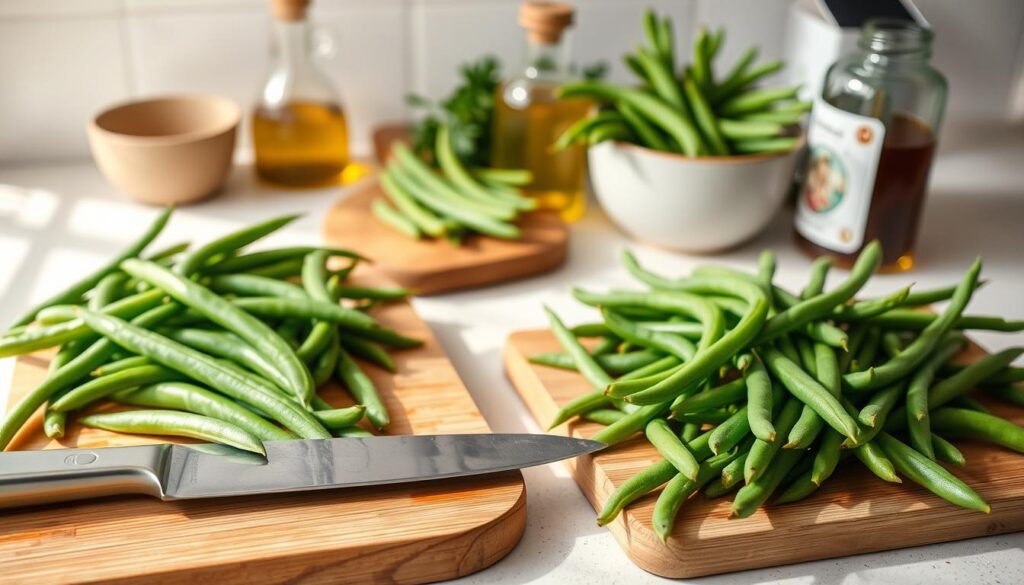
Half Runner Green Beans Recipes to Try
Looking for tasty ways to enjoy half runner green beans? We’ve got some simple and delicious recipes for you. These dishes bring out their crunchy texture and bright flavor. They’re perfect as side dishes or as the main attraction in your meals.
Here are a few standout recipes to inspire your cooking:
- Sautéed Half Runner Green Beans with Almonds: Quickly sauté 1 lb of fresh, trimmed half runner green beans in 2 tbsp of extra-virgin olive oil. Add 1/4 cup sliced almonds for a nutty crunch. A squeeze of lemon juice adds brightness.
- Half Runner Green Bean Salad: Mix 1 lb of blanched half runner green beans with 1 cup cherry tomatoes, halved, and 1/2 cup feta cheese. Dress with olive oil, balsamic vinegar, salt, and pepper for a refreshing option.
- Stir-Fried Half Runner Green Beans: Toss 1 lb of half runner green beans with soy sauce and garlic in a hot skillet. Add sliced bell peppers and enjoy a colorful, crunchy stir-fry.
Each of these half runner green beans recipes highlights the vegetable’s versatility and flavor. Whether you’re new to cooking or experienced, these dishes make it easy to add fresh green beans to your meals!
How to Preserve Half Runner Green Beans
Preserving half runner green beans lets us enjoy their fresh taste all year. First, pick the freshest and tenderest beans. Cut off the ends and trim them to halves or thirds for easier storage. Then, wash and drain the beans in a colander to clean them.
Next, lay the beans out on towels to dry for about 20 minutes. This step removes excess moisture. Once dry, portion and bag them. Use a vacuum sealer, like Food Saver, to remove air for better preservation. If you don’t have a vacuum sealer, freezer bags work too. Just use a straw to squeeze out air.
After sealing, label and date the bags for easy identification. The last step is to freeze the bags quickly at 0º or lower. Stack the bags flat in the freezer for neat storage. For more tips on freezing without blanching, see this guide on how to freeze green beans.
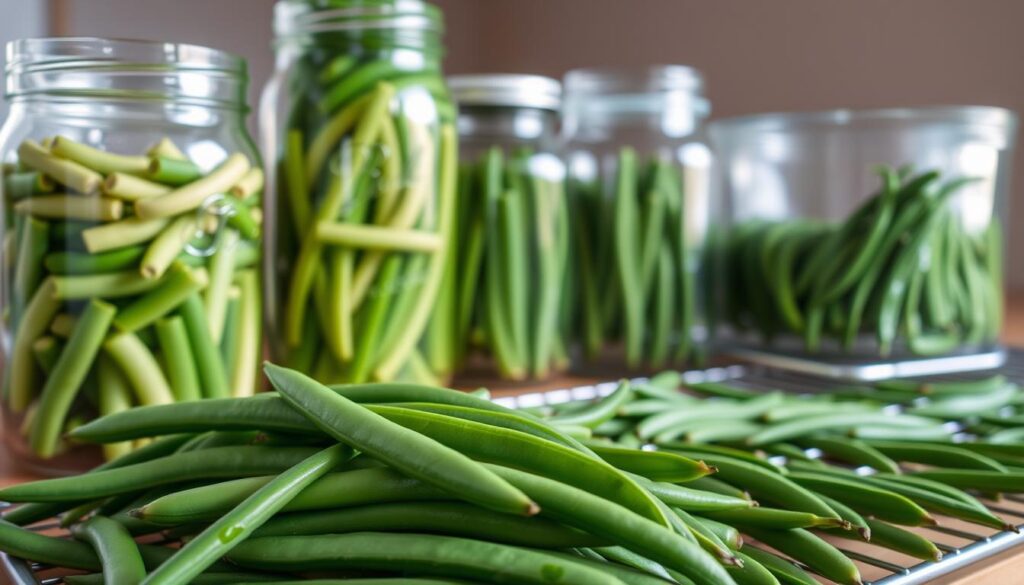
Where to Buy Half Runner Green Beans
Finding fresh or canned half runner green beans is easier than you think. Even without your own garden, you can find them. Here are some great places to look.
Local Farmers’ Markets: These markets often have seasonal produce, including half runner green beans. Buying from local farmers supports the community and ensures freshness.
Grocery Stores: Most supermarkets carry half runner green beans, fresh and canned. Look for brands like Del Monte and Green Giant for quality and freshness.
Online Retailers: For convenience, try buying half runner green beans online. Sites like Amazon and specialty grocery sites offer a variety, including organic options.
When picking half runner green beans, look for a bright green color and firm texture. Avoid beans that are browning or soft. This ensures they’re perfect for your meals.
Whether you shop locally or online, knowing where to buy half runner green beans makes cooking more fun and tasty!
Conclusion
Half runner green beans are easy to grow and offer many cooking options. They have a crisp texture and a great flavor. This makes them a hit in gardens and kitchens.
Try half runner green beans in your cooking. Enjoy them fresh or in a family meal. They can make any meal special.
Don’t be afraid to try new things with them. You’ll find endless delicious ways to use them. Share your experiences and inspire others to try half runner green beans.

